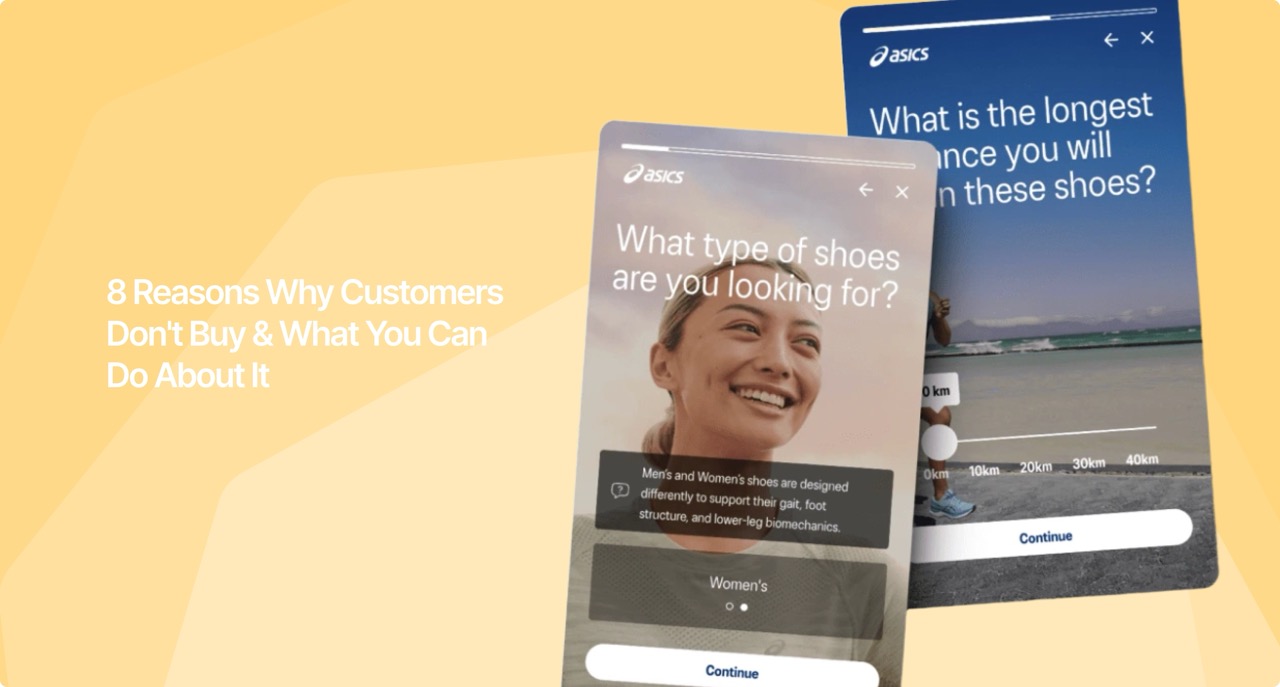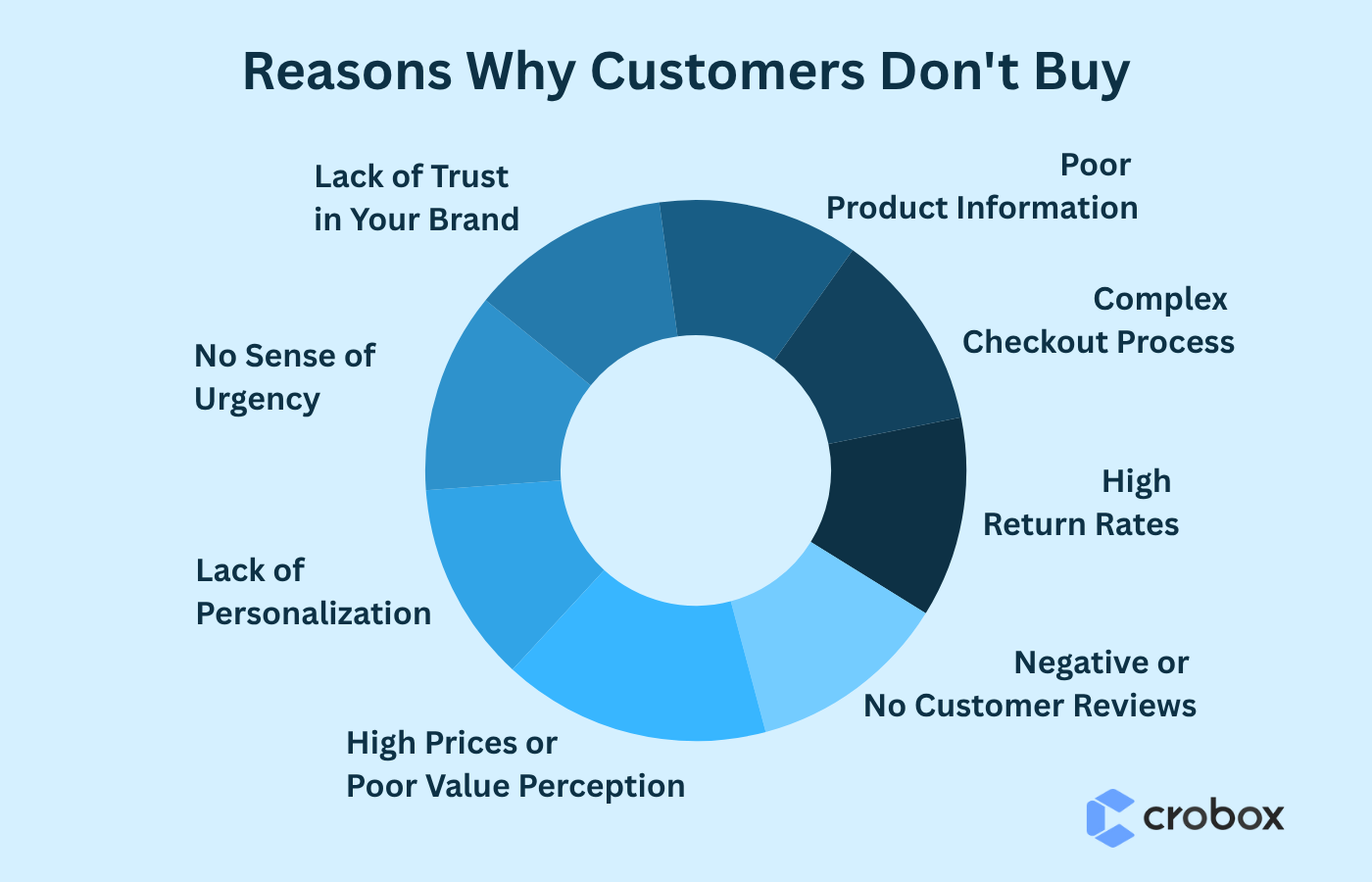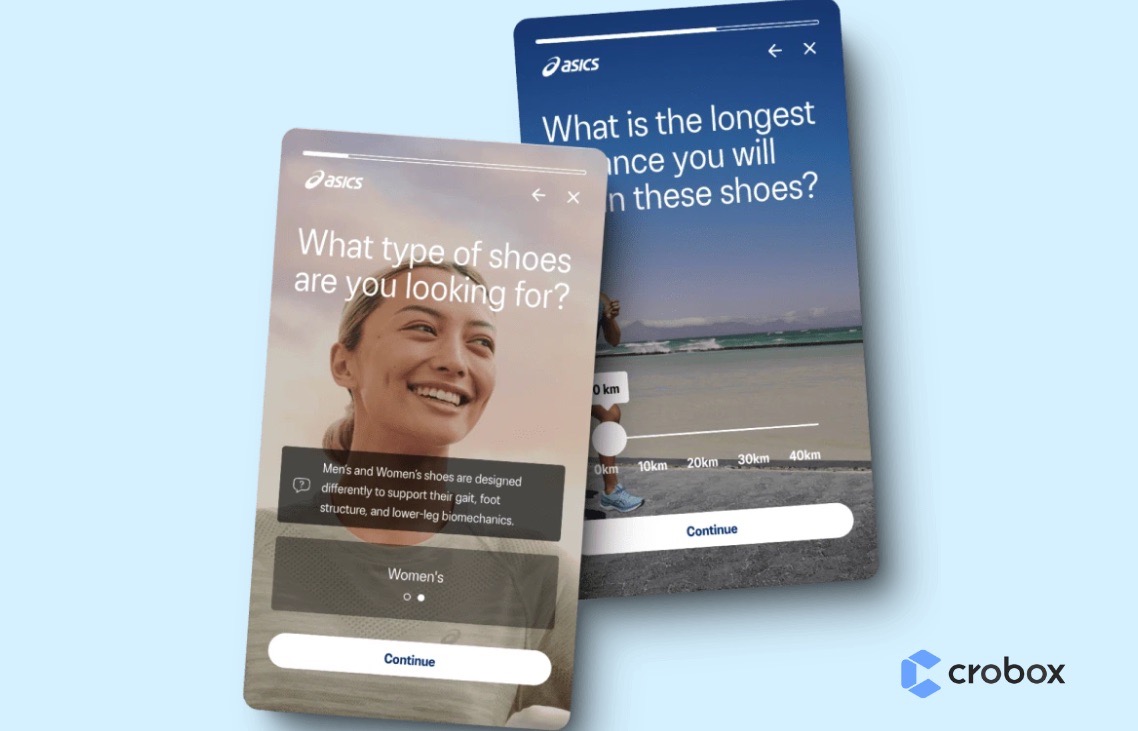
Every click, scroll, or abandoned cart tells a story about the behavior of your store visitors. For eCommerce teams, understanding why people don’t buy is a crucial element for continuous business growth.
Instead of investing in ads, SEO, and elegant product pages, high cart abandonment and return rates remain the top pain points to focus on. Shoppers browse and compare products, so after adding them to their cart, they just drop off without converting. Many of them still return products because of unmet expectations or a lack of confidence during the decision-making process.
So what’s wrong?
Most retailers still underestimate how behavior, psychology, and context drive purchase decisions. It is not just about the product or the price, but about relevance, trust, and timing. That’s why smarter solutions like Crobox’s Product Finder dominate the eCommerce industry in today’s modern era.
Keep reading and explore 8 powerful insights into why people hesitate or walk away from buying a specific product. More importantly, we will show you what to do about it, offering actionable solutions that can boost your conversions and reduce returns once in a while.

One of the biggest reasons why people don’t buy, especially from unfamiliar or new online stores, is a lack of trust. Shoppers can’t touch, try on, or test products in person, so they rely on features like reviews, transparency, and design to assess legitimacy. If those trust signals are weak or missing, the mistrust takes the pole position. According to Baymard Institute, nearly 18% of shoppers abandon their carts because of concerns about a website’s credibility.
There are inconsistent product descriptions, lack of customer proof, and many other micro-moments where shoppers ask themselves, “Can I really trust this brand?” And those moments kill conversions.
To build confidence, you should showcase authentic reviews, high-quality product images, and detailed specifications across the journey. Show other customers’ positive experiences, especially when they are new or shopping in high-consideration categories.
Without confidence in the product or brand, customers hesitate to commit, especially when purchasing high-value items. To break down these trust barriers, eCommerce businesses must create a transparent shopping experience at every step. For example:
Crobox’s behavioral insights offer a distinct advantage in this sphere too. After analyzing shopper behavior in real-time, retailers can serve product recommendations that highlight top-rated or frequently purchased items, boosting confidence through relevant social proof.
Additionally, pairing this with accessible customer support, like live chat or quick-response help widgets, lets shoppers know there is a real team behind the brand, ready to answer questions or resolve concerns instantly. This human touch further reduces hesitation and strengthens trust.
Without urgency, shoppers will delay purchases even when they want the product. In today's crowded eCommerce market, hesitation can easily turn into cart abandonment. Adding to this, customers often expect encouragement to act, and the high volume of similar offers makes it hard for any single store to stand out.
Research shows that limited-time offers and flash sales boost decision-making. For example, a study by Marketmind Shift reported that adding a countdown timer during a flash sale increased conversions by up to 40%. This highlights how effectively implemented urgency can transform browsing into buying.
To encourage faster decisions, use urgency strategically without ruining trust:
As you can use, urgency effectively means striking a balance between motivating action and maintaining customer trust. When urgency feels connected to real events or actual stock levels, shoppers are more likely to respond positively rather than feeling pressured or skeptical. This approach accelerates decision-making and improves the overall shopping experience, encouraging customers to buy confidently and reducing cart abandonment caused by hesitation.
Another big reason why people don’t buy is that the price feels too high, or worse, the product doesn’t feel worth the price. This is especially true in a competitive retail environment where shoppers are constantly comparing offers. This mismatch between price and value leads to hesitation, cart abandonment, and lost revenue. Even if your product is perfectly priced, if you fail to communicate the “why” behind its value, features, benefits, or how it fits their needs, customers will look elsewhere.
Start by evaluating whether your pricing reflects your brand promise and competitive eCommerce market. Bundling products or offering exclusive seasonal discounts can help drive purchases without damaging your margins.
You can also fix this issue with personalized product recommendations that increase relevance and perceived value. Crobox’s Product Finder and behavior-based product recommendations identify upsell and cross-sell opportunities that feel a perfect fit for the shopper. Instead of just suggesting “more expensive” items, Crobox connects intent and context to guide shoppers toward products that meet their needs, improving conversion and Average Order Value (AOV).

When shoppers land on a product page, they rely on the quality of the information presented. If images are blurry, descriptions are too technical or vague, or key specs are missing, they are more likely to leave without buying. One of the top reasons for not making the purchase is simply not understanding what the product offers or whether it meets their needs.
According to Salsify’s consumer research, 87% of shoppers say product content is extremely or very important when deciding to buy, and 30% would abandon a purchase due to poor product details. This aligns with one of the most overlooked answers to why people don't buy: lack of clarity.
Clear, precise, and compelling product descriptions are your first line of defense. Combine these with high-quality images, videos, and even user-generated content to bring the product to life. Show the item from multiple angles and in real-life use cases to reduce ambiguity.
Crobox fixes this even further by transforming product data into customer-friendly messaging. Through product data enrichment and AI-powered copy, Crobox helps retailers communicate product value with ease. Instead of listing specs, the experience becomes a guided explanation of why a specific product matters, making it easier for customers to evaluate and convert.
Why people don’t buy is a complicated or confusing checkout process. Even if shoppers find what they need, a poor checkout experience can derail the entire journey. For example:
Research from the Baymard Institute clearly shows that nearly 1 out of 5 shoppers abandon their carts because of a long or complicated checkout process. If the checkout phase becomes a blocker, all your effort in delivering personalized product recommendations or building shopper trust goes underwater.
To address this issue, retailers must reduce complexity. Offer guest checkout options, minimize the number of steps required to complete a purchase, and include visual elements like progress indicators.
Crobox’s Product Finder plays a pivotal role here. Providing shoppers with tailored product recommendations based on real-time behavior and preferences, this tool sets the stage for a more guided path to purchase. When customers feel understood and supported, they are less likely to abandon their carts mid-checkout. This drastically increases conversion rates and improves the overall shopping experience from discovery to decision.
Because the eCommerce market today is overcrowded, generic, and one-size-fits-all experiences just don’t cut it. Shoppers expect brands to recognize their preferences, anticipate their needs, and respond in real time. When customers face irrelevant product recommendations or non-personal site interactions, they are far more likely to close the site or abandon their carts entirely.
The gap between shopper expectations and what many retailers deliver is growing. This disconnect is one of the biggest reasons why people don’t buy today, especially when they feel unseen or misunderstood by a brand.
To prevent such a scenario, retailers must lean into personalized product recommendations. This means more than just showing “recently viewed” items, it is about leveraging behavioral signals, intent data, and shopping patterns to guide individuals to the right products at the right time.
Crobox’s Product Finder helps bridge this gap by delivering behavior-based product recommendations that adapt in real-time. Instead of serving static suggestions, it uses psychology and AI to tailor the shopping journey, making it feel on-point, relevant, and truly personalized. The result? More confident shoppers, higher conversions, and fewer reasons for not making the purchase.
One of the most lucrative situations why customers don’t buy specific products in your store is a lack of trust, and nothing signals uncertainty more than products with few or no reviews. When shoppers can’t find real experiences from other people, it creates doubt. They start asking themselves: Will this product live up to the promise? Has anyone like me used it before? What if it’s a waste of money?
Even worse, negative reviews that go unanswered can turn hesitation into a strict “No.” In the era of modern eCommerce product discovery, customer reviews are often the final trigger shoppers need to make a confident purchase. Without them, people tend to abandon their carts or choose a competitor that feels more reliable.
We found the latest research showing that:
This is not just about star ratings, because reviews provide valuable context, real-life use cases, and proof that others have had a good (or bad) experience. In short, customer reviews influence the reasons why people buy and the reasons for not making the purchase.
To overcome review-related hesitation, brands should make social proof a key part of their strategy. If you are one of them, feel free to:
We at Crobox help brands go one step further. With behavior-based product recommendations, our system learns from shopper interactions and aligns recommendations with what matters most to your audience. Plus, our review stars feature can structure large volumes of reviews pulled from your product data to help users make informed decisions, boosting trust at every touchpoint.
This kind of AI-powered feedback integration makes all the difference between a shopper bouncing and a shopper buying.
High return rates are often a clear signal that something is off, either customers did not get what they expected, the product did not fit their needs, or there was a disconnect between what was shown online and what they received. Not only do returns eat into your profits, but they also ruin customer confidence and increase the chances of shoppers not coming back anymore.
Returns are particularly common in categories like apparel and footwear, where size and fit can be difficult to judge online. But across the board, poor product information, misleading images, or irrelevant recommendations contribute to dissatisfaction that leads to returns.
In fact, product returns cost retailers billions annually, and high return rates are often connected to a lack of personalization or context-aware product discovery.
One of the most effective ways to reduce returns is by helping shoppers make more confident, informed decisions before they click "buy." That means:
This is where Crobox’s Product Finder shines. By learning from real-time shopper behavior and preferences, it recommends products that are more likely to align with individual shopper needs. That means fewer surprises after delivery and fewer returns as a result. Personalized product recommendations increase conversion rates and lead to higher satisfaction and retention afterward.
Don’t let common buying barriers hold your eCommerce business back. Understanding why customers hesitate to buy is important for converting more visitors into loyal shoppers. Here are the key reasons why aren't people shopping today and what you can do about them:
Crobox’s Product Finder leverages behavioral data and customer insights to fix these barriers firsthand. This tool delivers personalized product suggestions, and it helps customers find exactly what they want, quickly and confidently. This leads to higher conversions, no returns, and stronger customer trust. That’s how you will provide a smoother shopping journey that turns casual visitors into satisfied buyers.
Take the next step to transform your eCommerce performance and book a demo now to discover how Crobox can boost your sales and build lasting customer loyalty. Don’t miss out on the chance to make every visit count and start the change today.